
Looting of Venice: edging blocks in Istria stone
Powered by |
Saccheggio di Venezia, I blocchi in pietra d'Istria delle rive Looting of Venice: edging blocks in Istria stone |
| back |
| Il furto delle sponde | Edging blocks robbery |
|---|---|
|
Se le colonnine sono un manufatto prezioso, anche la pietra d'Istria in blocchi è diventata molto rara, così qualcuno sembra aver pensato a Venezia, che in secoli di dominazione sull'alto Adriatico ne importò migliaia di tonnellate. Gli ammanchi più recenti si verificano alle Zattere e alla Giudecca, dove nel corso dei lavori di costruzione della nuova banchina portuale sono stati sostituiti centinaia di blocchi, spogliando le rive per centinaia di metri per rivestirle di volgarissimo "biancone", pietra scadente e quasi gessosa. Particolarmente dolorosa è la perdita delle pietre poste sulle Zattere fra gli Incurabili e la Punta della Dogana: questa zona era caratterizzata da masegni e pietra d’Istria di posa assai antica. Certo gli spigoli di quelle pietre non erano affilati, recando i segni della loro età e del loro servizio. Ma era proprio quella loro storia, scritta nelle piccole sbrecciature dei bordi, a conferire a quei luoghi l’atmosfera magica antica e solitaria. Quell’atmosfera attirava le persone sensibili a passeggiare non solo nei giorni di sole, ma in ogni occasione si sentisse il bisogno di un momento di raccoglimento interiore. Molti ricorderanno con rimpianto anche i fossili di ammonite che si potevano vedere sulla pietra d’Istria vicino al ponte dell’Umiltà. Ora tutte quelle pietre gravide di storia non sono più lì. Sono sostituite da una banchina geometricamente squadrata che restituisce al visitatore la sensazione di trovarsi di fronte a un manufatto freddamente nuovo. Senza che a questa novità si accompagnino vantaggi di solidità o perfezionamento tecnico: i lavori sono condotti con massiccio uso di calcestruzzo e con posa delle pietre su sabbia, tecnologia già provatamente inadatta alla specificità veneziana. |
If small columns are a precious handicraft, and Istrian stone blocks themselves have become very rare, so it seems that somebody has thought of the thousands of tons of them imported by Venice during the centuries of its domination of the upper Adriatic Sea. The most recent areas where columns and stones have gone missing are on Zattere and Giudecca where, during the rebuilding of the canal banks, hundreds of blocks were removed and substituted with a poor, chalky, stone called "biancone". Particularly upsetting is the loss of the stones on the Zattere between Incurabili and Punta della Dogana. This area was characterised by its 16th century "masegni" and Istrian stone. The edges of these stones had been rounded off and bevelled over time, showing their age and service. It was that history, written in the small irregularity of edges and other signs of centuries of use, which gave those places their ancient atmosphere, both magical and isolated; that atmosphere, which attracts thoughtful and sensitive persons throughout the year, for it is very conducive at those times when one needs to reflect or concentrate. Many people also miss the large ammonite fossils that could be seen in the Istrian stone near the Umiltà bridge. Now those historical stones are no more. They have also been taken away and not returned, and substituted with a geometrically squared bank, which gives visitors the feeling of a brand-new and cold work. And yet even this new building does not provide the "advantages" usually seen in and obtained with up-to-date construction. Large amounts of concrete have been used, and the blocks have been set in sand, a technique that has been widely demonstrated as being inadequate in specific Venetian situation. |
Documentazione fotografica / Photographic documentation
| Zattere ai Saloni: tutta la riva originale se ne è andata, e con lei i fossili che vi si potevano scorgere. In cambio queste lastre di biancone tagliate a macchina. | 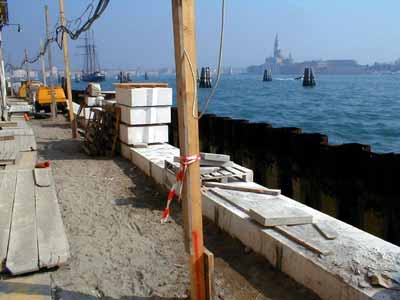 | Zattere ai Saloni: the whole original shore has gone, together with the fossils it contained. In its place we have machine-cut slabs of "biancone". |
| Zattere allo Spirito Santo: non hanno risparmiato neppure le rivette, la pietra d'Istria se n'è andata proprio tutta. | 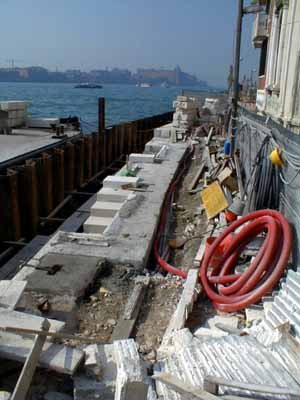 | Zattere allo Spirito Santo: here, not even the water stairs have been spared; all of the Istrian stone has gone. |
| Giudecca Sant'Eufemia: grossi blocchi di pietra d'Istria pronti per la spedizione, assieme a ingenti quantitativi di masegni. | 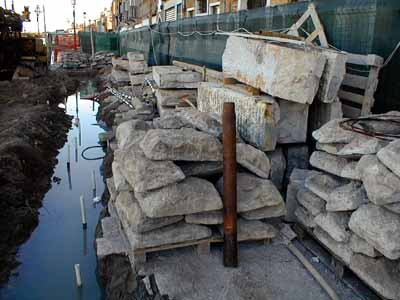 | Giudecca Sant'Eufemia: big Istrian stone blocks ready for removal, together with large amounts of "masegni" |
| Giudecca Sant'Eufemia: ancora blocchi di pietra d'Istria, ammonticchiati come materiale da cava. | 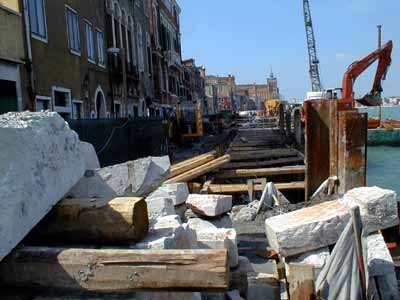 | Giudecca Sant'Eufemia: more Istrian stone blocks, piled up willy-nilly like rocks from a quarry. |
| Giudecca Zitelle: anche qui i grandi blocchi di pietra d'Istria delle rive se ne sono andati. | 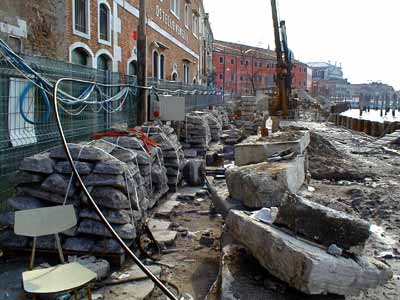 | Giudecca Zitelle: again, the big Istrian blocks previously here have been taken away and not returned. |
foto e testo di Umberto Sartory
back